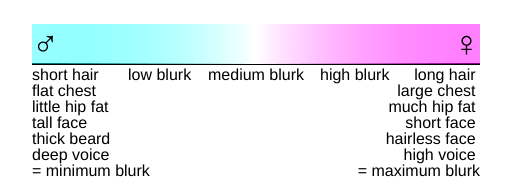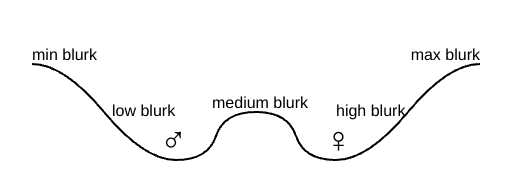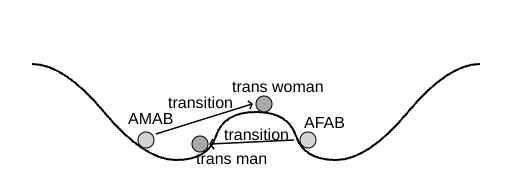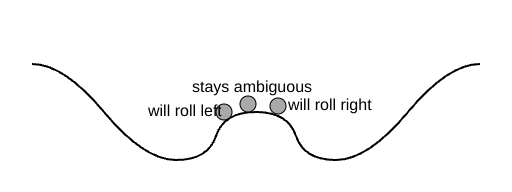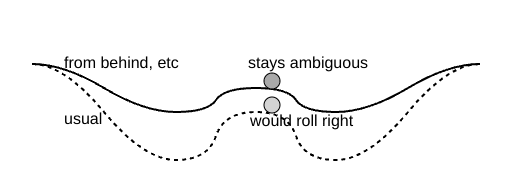Published on October 22, 2024 4:18 PM GMT
Among human populations I'm familiar with, all of these variables of appearance positively correlate:
- hair lengthchest protrusionproportion of body fat at hipsnegative facial heightabsence of facial hairvoice pitch
There are more variables clearly correlated with these. These are just the first that come to mind.
If you see a lot of variables correlating like that, you will infer a hidden variable unifying them. Let's approximate that variable as a weighted average of those traits I listed. Call it "blurk" (a nonce word).
Sith blurk is a weighted average, medium blurk could come from a medium value for each trait. Or medium blurk could come from low values for some and high values for others. One person with long hair, large chest, little hip fat, a tall face with little hair, and a medium-pitch voice would have medium blurk.
It happens that most cisgender men have low blurk, and most cisgender women have high blurk.
Kinda. That diagram suggests that women and men respectively maximise and minimise blurk. In practice, cisgender (henceforth "cis") women cluster around a submaximal-but-high average amount of blurk, and, likewise, cis men around a superminimal-but-low average.
This is building up to a model of how I (and probably some other people) naturally perceive gender. More important than the (perhaps overcomplicated) model itself is the set of concept-handles it implies. How one should perceive gender, or the intrinsic nature of gender, is beyond my qualifications, let alone the scope of this document.
All the variables I listed leading to a blurk-value are superficial and quickly-perceived. Many deeper, less obvious, arguably more important traits also correlate with blurk. But blurk is only useful as an intermediate variable in often-subconscious perception. What matters when defining blurk is what I first see.
Perceiving a person almost always includes perceiving a gender. The usual approximation relies on the two main blurk-clusters, rounding everyone to "woman" or "man" according to the nearest blurk-cluster-centre. But brains tend to think continuously, in spectra, rather than abruptly, in 'chotomies. So the rounding happens more gradually, like balls rolling down into valleys due to gravity.
Seeing a person places a ball along this virtual terrain according to their blurk. The ball then rolls based on local slope. It eventually reaches one of two local minima, solidifying a gender-judgment.
But brains tend to think crudely, with noise, rather than cleanly, with simple equations. So this terrain of traits has a rough ground. The balls rolls hindered by friction.
You can also voluntarily push a ball in either direction, before it starts rolling, with a limited amount of pushing-energy.
Transgender (henceforth "trans") people often deliberately change their appearance as part of a transition. Much of this change is targeted to shift their initial blurk towards the cluster of cis members of their self-identified gender; they may think of the transition otherwise, but this is the common effect.
Sans surgery or long-term hormone use, most transitions shift blurk toward the middle region, between clusters, rather than strictly into the desired valley. With constant energy, a push goes the furthest along flatter slopes, which shows up in blurk-land in that middle region. So voluntarily pushing balls in the terrain of perception, after computing initial blurk, is most impactful when perceiving trans people.
An observer who seeks to respect a trans person's gender pushes the ball towards the desired valley, making it more likely to end up at the bottom there. An observer willfully perceiving sex, rather than self-identity, would push the ball away from the desired valley. Either way, the energy is limited: a trans person without any appearance change will inevitably be seen according to their sex, and one who clearly passes (definitionally) will be seen by gender.
Non-binary people may seek to be perceived as such. Seeing someone as non-binary comes from the virtual ball sitting stable, rather than falling into a gorge. This can only happen on flat slopes with strong friction, so a non-binary person is only seen as such when their post-transition appearance (plus the observer's voluntary mental push) lands deep in the middle.
Slopes are steeper when you're more confident in the blurk-values. Less visible traits make the valleys more shallow. Many blurky traits are face-based, so wearing a mask makes the viewer's virtual valleys much more shallow. Looking from a distance, looking from behind, other extra clothing, etc, also make the valleys more shallow.
In those cases, rolling is slower and pushing-energy goes further. Gender perception comes to depend more on declarative memory than immediate sight.
Discuss


